1. Introduction
[qwiz]
[h]Hardy-Weinberg Review
[q]According to the Hardy-Weinberg Principle, allele frequencies in a gene pool stay constant, as long as five conditions are met. What are they?
[c]U2hvdyB0aGUgYW5zd2Vy[Qq]
[f]
Cg==- Cg==
- VGhlIHBvcHVsYXRpb24gaXMgbGFyZ2U= Cg==
- [Qq]The population is isolated (there’s no gene flow)
- Mutation is random
- Mating is random (there’s no sexual selection).
- There are no harmful or beneficial alleles (no natural selection).
[/qwiz]
Changes in allele frequencies are known at microevolution. In the last tutorial, we looked at microevolutionary change caused by natural selection. In this tutorial, we’ll look at the microevolutionary effects of mutation and small population size.
2. Mutation and Evolution
2a. Most Mutations are harmful, but heterozygote advantage shows us that the context matters
As you learned in AP Bio Unit 6, mutations are random changes in a nucleotide sequence (or in an entire chromosome, though that’s beyond the scope of what we’ll be discussing below). Because mutations occur within the context of living things that have been subject to natural selection, most random changes will take something functional and make it non-functional.
Here are a few examples:
- A single nucleotide substitution causes sickle cell anemia. To review the protein chemistry and molecular genetics of sickle cell anemia, click here.
- A deletion of three nucleotides in a gene that codes for a membrane protein causes cystic fibrosis.
- A four-base insertion in the gene for a lipid-digesting enzyme causes a frameshift mutation that results in Tay-Sachs disease.
Natural selection can drive the frequency of alleles for harmful mutations down to a low level. But we saw, in the last tutorial, how harmful alleles (whether recessive or dominant) can persist for a long period of time.
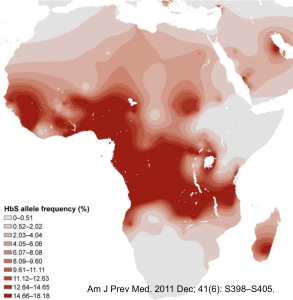
Here’s another reason why harmful alleles might persist in a gene pool: a mutation that’s negative in one context can be positive in another. Let’s look again at sickle cell anemia. You’d expect that a disease that through much of history was fatal during childhood to anyone who inherited two copies of the allele would be in very low frequency. Yet the sickle cell allele is in relatively high frequency in certain parts of sub-Saharan Africa.
In some areas, the frequency of the sickle cell allele rises up to 18%. Knowing that, use the Hardy-Weinberg equation to calculate the frequency, in these populations, of children born with the disease, of heterozygotes, and of people who are homozygous normal. Complete your calculations in your student learning guide, and then check your work below.
[qwiz summary=”false” qrecord_id=”sciencemusicvideosMeister1961-Sickle cell Hardy-Weinberg calculations (v2.0)”]
[h] Sickle cell Hardy-Weinberg calculations
[q] Start by putting 0.18 in the upper right and lower left squares.
| A | a (.18) | |
| A | AA | Aa |
| a (.18) | Aa | aa |
Now use p + q = 1 to solve for the frequency of the dominant allele.
[q]
| A (.82) | a (.18) | |
| A (.82) | AA | Aa |
| a (.18) | Aa | aa |
Now cross multiply
[q]
| A (.82) | a (.18) | |
| A (.82) | AA (.67) | Aa (.15) |
| a (.18) | Aa (.15) | aa (.03) |
Now determine 2pq
[x]
| A (.82) | a (.18) | |
| A (.82) | AA (.67) | Aa (.15) |
| a (.18) | Aa (.15) | aa (.03) |
RESULT: If the frequency of the (recessive) sickle cell allele is 18%, then 3% of children will be born with sickle cell anemia and 30% of children will be heterozygotes.
[/qwiz]
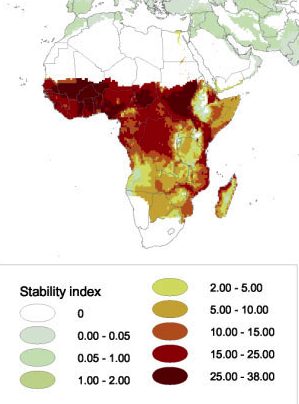
The high frequency of the disease in certain areas is explained by the fact that these same areas also have high rates of malaria. Malaria is a serious blood disease caused by a parasite that is carried from person to person by mosquitoes. While heterozygotes are, when viewed from the outside, mostly symptom-free, on the inside (in their blood cells), there is some expression of the mutated form of the hemoglobin protein. The presence of some of this mutated hemoglobin is not enough to cause sickle cell anemia, but it does create a condition in heterozygotes called “sickle cell trait” (which you can learn about by clicking on the previous link).
In terms of understanding the high frequency of the sickle cell allele in areas with high levels of malaria, the important thing to know is that the presence of the mutated hemoglobin in heterozygotes disrupts the life cycle of the malaria-causing parasite. In other words, if you’re a heterozygote, you have some protection against malaria, which can be a lethal disease.
As a result, in relation to the sickle cell allele, natural selection pulls in two directions. On the one hand, there’s always selection against the allele, because it causes a very harmful condition (sickle cell anemia) in homozygous recessives. On the other hand, in areas with high levels of malaria, there’s selection for the allele, because it protects heterozygotes from malaria. As a result, in areas with high levels of malaria, the frequency of the allele rises. You can see this relationship by comparing the map above to the map on the right, which shows the incidence of malaria in various parts of Africa.
This phenomenon, where harmful recessive alleles are in higher-than-expected frequency because having one copy of the allele is a selective advantage, is called heterozygote advantage (the link takes you to a Wikipedia article in a new tab). Heterozygote advantage has also been proposed to explain the high frequency of the cystic fibrosis allele in European populations, where approximately 1 in 25 people is a carrier. The idea is that being heterozygous for the cystic fibrosis allele confers a possible survival advantage in the face of the bacterial diseases cholera and tuberculosis, though this idea is controversial. No known heterozygote advantage has been identified for Tay-Sachs disease, which, historically, was carried by about 1 in 27 Jews of European descent.
2b. Some Mutations are silent
The mutations that cause cystic fibrosis, sickle cell anemia, and Tay-Sachs disease are all active mutations: they change one or more amino acids in the protein that the allele codes for. But as you learned in AP Bio Unit 6, because the genetic code has a lot of redundancy, some mutations will change the DNA, but not the amino acid that the DNA codes for. For example, the DNA triplets ACT, ACC, ACA, and ACG all code for the amino acid threonine. These kinds of mutations, which change DNA but not the protein being coded for, are known as silent mutations. Because they have no effect on the phenotype, they won’t be acted upon by natural selection.
2c. Mutations can be beneficial
Sometimes, a mutation improves a protein or a developmental pathway. When that happens, mutation becomes the basis for new adaptations to emerge. Throughout this course, we’ve seen this several times.
- In Unit 6, we saw how mutations in PitX1 gene enhancers created spineless forms of the threespine stickleback, enabling these fish to colonize freshwater environments.
- In the last tutorial, we saw how mutations in the M1CR gene created dark forms of the rock pocket mouse, enabling these mice to successfully colonize lava flows.
- In Unit 1, we saw how the emergence of lactase persistence in certain human populations enabled these populations to exploit a new food source (milk) and develop an entirely new lifestyle and culture.
- Immediately above, we saw how mutations in the gene for hemoglobin facilitate the survival of human populations in the face of malaria
But these are not isolated examples. Every adaptation started as a mutation, which was then subjected to natural selection. A mutation might, for example, improve the efficiency with which an enzyme binds to its substrate. Or, as Sean Carroll points out in his book The Making Of The Fittest, it might change a light receptor in an animal’s eye so that it can see a slightly different frequency of light energy, making it able to perceive prey that others without this mutation can’t see.
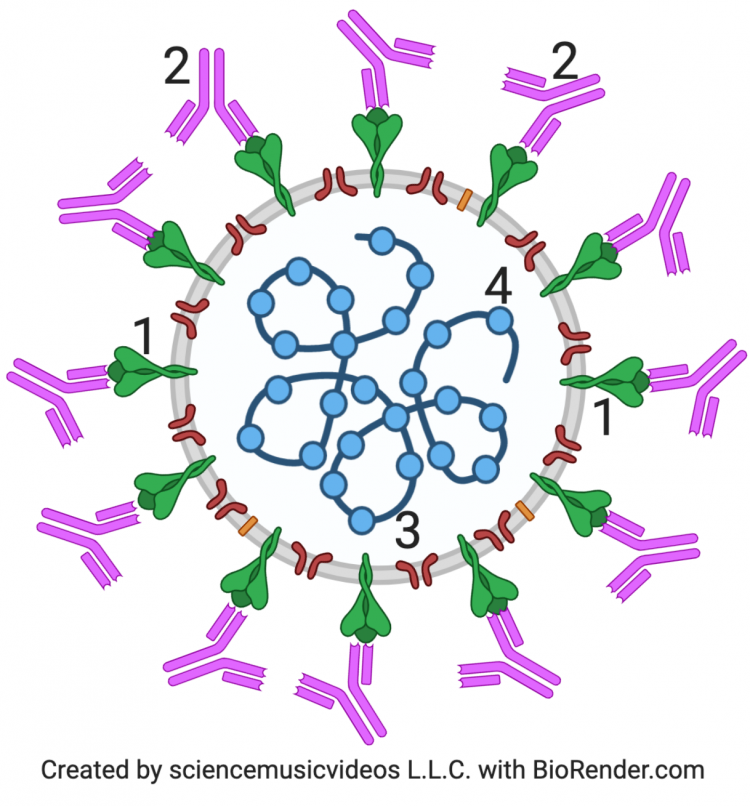
While the slow time scale of evolutionary change in animals like us can make the process of adaptation hard to see, we’ve been living through cycles of mutation and natural selection in real-time in relation to the evolution of SARS-CoV-2. Each wave of viral variants (Alpha, Delta, Omicron) has involved mutations in the genes for SARS-CoV-2’s spike protein (“1”, in the diagram to the left). While most of these mutations were negative (resulting in viruses that couldn’t complete their replication cycle), some resulted in viral variants that were more effective at entering cells, replicating, spreading from one person to the next, and evading the antibodies (2) of the human immune system. While this was negative from a human perspective, it was completely positive from the virus’s perspective.
3. Quiz: Mutation in Gene Pools
[qwiz qrecord_id=”sciencemusicvideosMeister1961-Mutation in Gene Pools (v2.0)”]
[h]Mutation in gene pools
[q]A change in a nucleotide sequence of a gene is called a(n) [hangman]
[c]IG11dGF0aW9u[Qq]
[q]True or false? When the environment changes, a population will evolve new mutations in order to be able to adapt.
[c]IFRydWU=[Qq]
[c]IEZh bHNl[Qq]
[f]IE5vLiBNdXRhdGlvbnMgYXJlIHJhbmRvbS4gRXZvbHV0aW9uYXJ5IGFkYXB0YXRpb24gaXMgYWJvdXQgcHJldmlvdXNseSBleGlzdGluZyB2YXJpYXRpb25zIGJlaW5nIHNlbGVjdGVkIGJ5IHRoZSBlbnZpcm9ubWVudCwgYW5kIGFsbGVsZSBmcmVxdWVuY2llcyBzaGlmdGluZyBpbiByZXNwb25zZS4=[Qq]
[f]IFRoYXTigJlzIGNvcnJlY3QuIE11dGF0aW9ucyBhcmUgcmFuZG9tLiBFdm9sdXRpb25hcnkgYWRhcHRhdGlvbiBpcyBhYm91dCBwcmV2aW91c2x5IGV4aXN0aW5nIHZhcmlhdGlvbnMgYmVpbmcgc2VsZWN0ZWQgYnkgdGhlIGVudmlyb25tZW50LCBhbmQgYWxsZWxlIGZyZXF1ZW5jaWVzIHNoaWZ0aW5nIGluIHJlc3BvbnNlLg==
Cg==Cg==[Qq]
[q]A mutation causes a nucleotide sequence to change from
TGAGGTCTCCTC
to
TGAGGCCTCCTC
Both sequences code for the same amino acid sequence.
This type of mutation is known as a(n)
[c]IGluc2VydGlvbiBtdXRhdGlvbi4=[Qq]
[c]IGRlbGV0aW9uIG11dGF0aW9uLg==[Qq]
[c]IHNpbGVudCBt dXRhdGlvbi4=[Qq]
[c]IGZyYW1lc2hpZnQgbXV0YXRpb24u[Qq]
[f]IE5vLiBBbiBpbnNlcnRpb24gbXV0YXRpb24gd291bGQgYWRkIGEgbmV3IG51Y2xlb3RpZGUgc29tZXdoZXJlIGluIHRoZSBudWNsZW90aWRlIHNlcXVlbmNlLCBhbmQgcHVzaCBhbGwgdGhlIG90aGVyIG51Y2xlb3RpZGVzIG92ZXIgb25lIHBvc2l0aW9uLiBUaGUgbWFpbiBjb25zZXF1ZW5jZSBvZiB0aGlzIGlzIHRoYXQgaXQgY2hhbmdlcyB0aGUgcmVhZGluZyBmcmFtZSwgYW5kIGNoYW5nZXMgZXZlcnkgY29kb24gZG93bnN0cmVhbSBvZiB0aGUgbXV0YXRpb24uIE5leHQgdGltZSwgY2hvb3NlIGEgdHlwZSBvZiBtdXRhdGlvbiB3aXRoIGEgbGVzcyBkcmFzdGljIGVmZmVjdC4=[Qq]
[f]IE5vLiBBIGRlbGV0aW9uIG11dGF0aW9uIHdvdWxkIHJlbW92ZSBhIG51Y2xlb3RpZGUgc29tZXdoZXJlIGluIHRoZSBudWNsZW90aWRlIHNlcXVlbmNlLCBhbmQgcHVsbCBhbGwgdGhlIG90aGVyIG51Y2xlb3RpZGVzIG9uZSBwb3NpdGlvbiBmb3J3YXJkLiBUaGUgbWFpbiBjb25zZXF1ZW5jZSBvZiB0aGlzIGlzIHRoYXQgaXQgY2hhbmdlcyB0aGUgcmVhZGluZyBmcmFtZSwgYW5kIGNoYW5nZXMgZXZlcnkgY29kb24gZG93bnN0cmVhbSBvZiB0aGUgbXV0YXRpb24uIE5leHQgdGltZSwgY2hvb3NlIGEgdHlwZSBvZiBtdXRhdGlvbiB3aXRoIGEgbGVzcyBkcmFzdGljIGVmZmVjdC4=[Qq]
[f]IEV4YWN0bHkuIEEgc2lsZW50IG11dGF0aW9uIGNoYW5nZXMgdGhlIEROQSBidXQgZG9lc27igJl0IGNoYW5nZSB0aGUgYW1pbm8gYWNpZHMgdGhhdCB0aGUgc2VxdWVuY2UgaXMgY29kaW5nIGZvci4=[Qq]
[f]IEEgZnJhbWVzaGlmdCBtdXRhdGlvbiByZXN1bHRzIGZyb20gZWl0aGVyIGluc2VydGluZyBvciBkZWxldGluZyBhIGJhc2UuIFRoZXNlIGluc2VydGlvbnMgY2hhbmdlIHRoZSByZWFkaW5nIGZyYW1lIGR1cmluZyB0cmFuc2xhdGlvbiBhbmQgY2F1c2UgbWFueSBvZiB0aGUgYW1pbm8gYWNpZHMgaW4gdGhlIHByb3RlaW4gdGhhdCB0aGUgZ2VuZSBjb2RlcyBmb3IgdG8gYmUgY2hhbmdlZC4gSW4gdGhlIGV4YW1wbGUgYWJvdmUsIHdoYXQgd2UgaGF2ZSBpcyBhIHNpbXBsZSBzdWJzdGl0dXRpb24gYW5kIG9uZSB0aGF0IGRvZXNu4oCZdCBjaGFuZ2UgZXZlbiBvbmUgYW1pbm8gYWNpZC4gQ2hvb3NlIGFub3RoZXIgYW5zd2VyIG5leHQgdGltZS4=
Cg==[Qq]
[q]What’s the most likely effect of a mutation that deletes one nucleotide near the start of a gene?
[c]IFRoZSBtdXRhdGlvbiB3aWxsIGNhdXNlIGEgc2luZ2xlIGFtaW5vIGFjaWQgdG8gYmUgY2hhbmdlZCBpbiB0aGUgcHJvdGVpbiB0aGF0IHRoaXMgZ2VuZSBjb2RlcyBmb3Iu[Qq]
[c]IFRoZSBtdXRhdGlvbiB3aWxsIGNhdXNlIGEgc2VyaWVzIG9mIGNoYW5nZXMg aW4gdGhlIGFtaW5vIGFjaWRzIHRoYXQgdGhlIGdlbmUgY29kZXMgZm9yLg==[Qq]
[c]IFRoZSBtdXRhdGlvbiB3aWxsIGNhdXNlIG5vIGNoYW5nZSBpbiB0aGUgcmVzdWx0aW5nIHByb3RlaW4u[Qq]
[f]IE5vLiBJZiBhIHNpbmdsZSBudWNsZW90aWRlIGlzIGRlbGV0ZWQgbmVhciB0aGUgc3RhcnQgb2YgYSBnZW5lLCB0aGVuIHRoZSDigJhyZWFkaW5nIGZyYW1l4oCZIGZvciBhbGwgc3Vic2VxdWVudCBjb2RvbnMgd2lsbCBiZSBzaGlmdGVkLiBBbG1vc3QgYWxsIHRoZSBjb2RvbnMgd2lsbCBiZSBpbmNvcnJlY3RseSByZWFkLCBjaGFuZ2luZyBtYW55IGFtaW5vIGFjaWRzIGluIHRoYXQgcHJvdGVpbi4=[Qq]
[f]IFRoYXTigJlzIHRoZSBtb3N0IGxpa2VseSByZXN1bHQuIElmIGEgc2luZ2xlIG51Y2xlb3RpZGUgaXMgZGVsZXRlZCBuZWFyIHRoZSBzdGFydCBvZiBhIGdlbmUsIHRoZW4gdGhlIOKAmHJlYWRpbmcgZnJhbWXigJkgZm9yIGFsbCBzdWJzZXF1ZW50IGNvZG9ucyB3aWxsIGJlIHNoaWZ0ZWQuIEFsbW9zdCBhbGwgdGhlIGNvZG9ucyB3aWxsIGJlIGluY29ycmVjdGx5IHJlYWQsIGNoYW5naW5nIG1hbnkgYW1pbm8gYWNpZHMgaW4gdGhhdCBwcm90ZWluLg==[Qq]
[f]IFRoYXTigJlzIG5vdCBjb3JyZWN0LiBJZiBhIHNpbmdsZSBudWNsZW90aWRlIGlzIGRlbGV0ZWQgbmVhciB0aGUgc3RhcnQgb2YgYSBnZW5lLCB0aGVuIHRoZSDigJhyZWFkaW5nIGZyYW1l4oCZIGZvciBhbGwgc3Vic2VxdWVudCBjb2RvbnMgd2lsbCBiZSBzaGlmdGVkLiBBbG1vc3QgYWxsIHRoZSBjb2RvbnMgd2lsbCBiZSBpbmNvcnJlY3RseSByZWFkLCBjaGFuZ2luZyBtYW55IGFtaW5vIGFjaWRzIGluIHRoYXQgcHJvdGVpbi4gSXQgbG9va3MgbGlrZSB5b3Ugd2VyZSB0aGlua2luZyBhYm91dCBhIOKAmHNpbGVudCBtdXRhdGlvbizigJkgd2hpY2ggaXMgd2hlbiBhIG11dGF0aW9uIGNoYW5nZXMgdGhlIEROQSwgYnV0IG5vdCB0aGUgcHJvdGVpbi4gVGhpcyBjYW4gaGFwcGVuIHdoZW4gb25lIG51Y2xlb3RpZGUgaXMgc3Vic3RpdHV0ZWQgZm9yIGFub3RoZXIsIGFuZCBpdCBoYXBwZW5zIGJlY2F1c2UgbWFueSBjb2RvbnMgYXJlIHN5bm9ueW1vdXMsIGFuZCBjb2RlIGZvciB0aGUgc2FtZSBhbWlubyBhY2lkLiBEZWxldGlvbnMsIGJ5IGNvbnRyYXN0LCBhcmUgYWxtb3N0IG5ldmVyIHNpbGVudC4=
Cg==[Qq]
[q]Insertion or deletion of a single nucleotide in a DNA sequence results in a
[c]IGZyYW1lc2hpZn QgbXV0YXRpb24u[Qq]
[c]IHNpbGVudCBtdXRhdGlvbi4=[Qq]
[c]IHBvaW50IG11dGF0aW9uIHRoYXQgZG9lc27igJl0IGNoYW5nZSB0aGUgcmVhZGluZyBmcmFtZS4=[Qq]
[f]IFRlcnJpZmljISBJbnNlcnRpb25zIG9yIGRlbGV0aW9ucw==wqA=aW4gdGhlIG51Y2xlb3RpZGUgc2VxdWVuY2UgZWl0aGVyIHB1c2ggYWxsIHRoZSBudWNsZW90aWRlcyBkb3duIG9yIHB1bGwgdGhlbSBhbGwgZm9yd2FyZC4=wqA=VGhlIG1haW4gY29uc2VxdWVuY2Ugb2YgdGhpcyBpcyB0aGF0IGl0IGNoYW5nZXMgdGhlIHJlYWRpbmcgZnJhbWUsIGFuZCBjaGFuZ2VzIGV2ZXJ5IGNvZG9uIGRvd25zdHJlYW0gb2YgdGhlIG11dGF0aW9uLg==[Qq]
[f]IE5vLiBBIHNpbGVudCBtdXRhdGlvbiBjaGFuZ2VzIHRoZSBETkEsIHdpdGhvdXQgY2hhbmdpbmcgYW55IG9mIHRoZSBhbWlubyBhY2lkcyB0aGUgZ2VuZSBjb2RlcyBmb3IuIEluc2VydGlvbnMgb3IgZGVsZXRpb25zIGluIHRoZSBudWNsZW90aWRlIHNlcXVlbmNlIGVpdGhlciBwdXNoIGFsbCB0aGUgbnVjbGVvdGlkZXMgZG93biBvciBwdWxsIHRoZW0gYWxsIGZvcndhcmQuwqA=VGhlIG1haW4gY29uc2VxdWVuY2Ugb2YgdGhpcyBpcyB0aGF0IGl0IGNoYW5nZXMgdGhlIHJlYWRpbmcgZnJhbWUsIGFuZCBjaGFuZ2VzIGV2ZXJ5IGNvZG9uIGRvd25zdHJlYW0gb2YgdGhlIG11dGF0aW9uLiBTZWUgaWYgeW91IGNhbiBmaW5kIGEgY2hvaWNlIHRoYXQsIGluIGEgc2luZ2xlIHdvcmQsIGNhcHR1cmVzIHdoYXQgaGFwcGVucyB3aXRoIGluc2VydGlvbnMgb3IgZGVsZXRpb25zLg==[Qq]
[f]IE5vLiBUaGUga2V5IHBvaW50IGhlcmUgaXMgdGhhdCBpbnNlcnRpbmcgb3IgZGVsZXRpbmcgYSBudWNsZW90aWRlIGZyb20gYSBETkEgc2VxdWVuY2Ugc2hpZnRzIGV2ZXJ5IG51Y2xlb3RpZGUgZm9yd2FyZCBvciBiYWNrd2FyZC4gVGhpcyBkb2VzIGNoYW5nZSB0aGUgcmVhZGluZyBmcmFtZS4gTmV4dCB0aW1lLCBjaG9vc2UgYW5vdGhlciBhbnN3ZXIu
Cg==[Qq]
[q]Which type of mutation is most likely to be acted upon by natural selection?
[c]IEEgc2lsZW50IG11dGF0aW9uICh3aGljaCBvbmx5IGNoYW5nZXMgdGhlIEROQSk=[Qq]
[c]IEFuIGFjdGl2ZSBtdXRhdGlvbiAod2hpY2ggY2hhbmdlcyB0aGUg RE5BLCBhbmQgdGhlIHByb3RlaW4gdGhlIEROQSBjb2RlcyBmb3Ip[Qq]
[f]IE5vLiBTaWxlbnQgbXV0YXRpb25zIGhhdmUgbm8gZWZmZWN0IG9uIGFuIG9yZ2FuaXNt4oCZcyBwaGVub3R5cGUuIFNpbmNlIG5hdHVyYWwgc2VsZWN0aW9uIG9ubHkgYWN0cyBvbiB0aGUgcGhlbm90eXBlLCBzaWxlbnQgbXV0YXRpb24gY2Fu4oCZdCBiZSBhY3RlZCBvbiBieSBuYXR1cmFsIHNlbGVjdGlvbi4=[Qq]
[f]IFRoYXTigJlzIGNvcnJlY3QuIEFjdGl2ZSBtdXRhdGlvbnMgY2hhbmdlIHByb3RlaW4sIHdoaWNoIGNoYW5nZXMgYW4gb3JnYW5pc23igJlzIHBoZW5vdHlwZS4gU2luY2UgbmF0dXJhbCBzZWxlY3Rpb24gYWN0cyBvbiBhbiBvcmdhbmlzbeKAmXMgcGhlbm90eXBlLCBhY3RpdmUgbXV0YXRpb25zIGJlY29tZSB0YXJnZXRzIGZvciBzZWxlY3Rpb24u
Cg==[Qq]
[q]The most common consequence of an active mutation is for there to be
[c]IGltcHJvdmVtZW50IG9mIHRoZSBwcm90ZWluLCBtYWtpbmcgaXQgbW9yZSBlZmZlY3RpdmUgYW5kIGluY3JlYXNpbmcgYW4gb3JnYW5pc20mIzgyMTc7cyBwcm9iYWJpbGl0eSBvZiBzdXJ2aXZhbC4=[Qq]
[c]IG5vIGltcGFjdCBvbiB0aGUgb3JnYW5pc23igJlzIHBoZW5vdHlwZS4=[Qq]
[c]IGRhbWFnZSB0byBhIGZ1bmN0aW9uaW5nIHByb3RlaW4sIHJlc3VsdGluZyBpbiBk aXNlYXNlIGZvciB0aGUgb3JnYW5pc20gdGhhdCBiZWFycyB0aGUgbXV0YXRpb24u[Qq]
[f]IE5vLiBXaGlsZSB0aGlzIGlzIHBvc3NpYmxlLCBhbmQgYW4gaW1wb3J0YW50IHBhcnQgb2YgZXZvbHV0aW9uLCBpdOKAmXMgdmVyeSB1bmxpa2VseS4gTXV0YXRpb25zIGFyZSByYW5kb20gY2hhbmdlcywgYW5kIHJhbmRvbSBjaGFuZ2VzIGFyZSBtb3JlIGxpa2VseSB0byBicmVhayB0aGluZ3MgdGhhbiB0byBmaXggdGhlbS4=[Qq]
[f]IE5vLiBCeSBkZWZpbml0aW9uLCBhbiBhY3RpdmUgbXV0YXRpb24gaXMgY2hhbmdpbmcgYSBwcm90ZWluLiBQcm90ZWlucywgb24gc29tZSBsZXZlbCwgYXJlIHdoYXQgbWFrZSB1cCBhbiBvcmdhbmlzbeKAmXMgcGhlbm90eXBlIChlaXRoZXIgZGlyZWN0bHksIG9yIHRocm91Z2ggZW56eW1lcyB0aGF0IGNvbnRyb2wgZGV2ZWxvcG1lbnQpLg==[Qq]
[f]IFllcy4gTXV0YXRpb24gaXMgdGhlIGNhdXNlIG9mIG1hbnkgZ2VuZXRpYyBkaXNlYXNlcy4gVGhlIG1vc3QgbGlrZWx5IGltcGFjdCBvZiBhIG11dGF0aW9uIGlzIHRvIHRha2UgYSBwcm90ZWluIHRoYXTigJlzIHdvcmtpbmcgYW5kIGRpbWluaXNoIG9yIGRlc3Ryb3kgaXRzIGZ1bmN0aW9uLg==
Cg==[Qq]
[q]In a population, a specific gene has two alleles, “A” and ‘a.’ Individuals with genotype ‘aa’ die in early childhood. Individuals with genotype ‘Aa’ have a higher rate of surviving and reproducing than individuals with genotype ‘AA.’ This phenomenon is called
[c]IG11dGF0aW9uIHNlbGVjdGlvbi4=[Qq]
[c]IGhldGVyb3p5Z290 ZSBhZHZhbnRhZ2Uu[Qq]
[c]IGFsbGVsZSBzZWxlY3Rpb24u[Qq]
[f]IE5vLiBXaGlsZSB0aGlzIHdpbGwgYWx0ZXIgdGhlIGZyZXF1ZW5jeSBvZiBhbGxlbGVzIGluIHRoaXMgcG9wdWxhdGlvbiBpbiBmYXZvciBvZiB0aGUgbGV0aGFsIGFsbGVsZSwgdGhhdOKAmXMgbm90IHRoZSBuYW1lIHRoYXTigJlzIHVzZWQuIFRoaW5rIGFib3V0IHdoaWNoIGdlbm90eXBlIGhhcyB0aGUgc3Vydml2YWwgYWR2YW50YWdlLg==[Qq]
[f]IFllcy4gVGhpcyBzaXR1YXRpb24sIHdoZXJlIGhldGVyb3p5Z290ZXMgc3Vydml2ZSBhdCBoaWdoZXIgcmF0ZXMsIGV2ZW4gdGhvdWdoIHRoZXkgY2FycnkgYSBsZXRoYWwgYWxsZWxlLCBpcyBjYWxsZWQgaGV0ZXJvenlnb3RlIGFkdmFudGFnZS4=[Qq]
[f]IE5vLiBPbiBhIHBvcHVsYXRpb24gZ2VuZXRpYyBsZXZlbCwgdGhlIGxldGhhbCBhbGxlbGUgd2lsbCB3aW5kIHVwIHdpdGggYSBtdWNoIGhpZ2hlciBmcmVxdWVuY3kgdGhhbiB3b3VsZCBiZSBleHBlY3RlZCBmb3IgYSBsZXRoYWwgYWxsZWxlLiBCdXQgdGhhdOKAmXMgbm90IHRoZSBuYW1lIGZvciB0aGlzIHBoZW5vbWVub24uIFRoaW5rIGFib3V0IHdoaWNoIGdlbm90eXBlIGhhcyB0aGUgc3Vydml2YWwgYWR2YW50YWdlLg==
Cg==[Qq]
[q]For this question, let ‘S’ represent the normal hemoglobin allele, and ‘s’ represent the sickle cell allele. In areas affected by malaria, which of the following sequences of genotypes correctly shows which genotype has the highest survival rate, followed by the second highest, followed by the lowest survival rate.
[c]IFNTLCBTcyzCoHNz[Qq]
[c]IHNzLCBTUyzCoFNz[Qq]
[c]IFNTLCBzcyzCoFNz[Qq]
[c]IFNzLC BTUyw=wqBzcw==[Qq]
[f]IE5vLiAmIzgyMjA7U1MmIzgyMjE7IGlzIHRoZSBub3JtYWwgaGVtb2dsb2JpbiBnZW5vdHlwZSwgYnV0IGluZGl2aWR1YWxzIHdpdGggdGhpcyBnZW5vdHlwZSBzdWZmZXIgZnJvbSBtYWxhcmlhLiBZb3XigJlyZSBjb3JyZWN0IGluIHB1dHRpbmcgJiM4MjIwO3NzJiM4MjIxOyBsYXN0IHNpbmNlIGl0IHJlc3VsdHMgaW4gc2lja2xlIGNlbGwgYW5lbWlhLCBhIHNlcmlvdXMgZGlzZWFzZS4gVGhpbmsgYWJvdXQgd2hpY2ggZ2Vub3R5cGUgcHJvZHVjZXMgYSBwaGVub3R5cGUgdGhhdCBkb2VzIGJlc3QgaW4gbWFsYXJpYS1hZmZlY3RlZCBhcmVhcywgYW5kIGNob29zZSBhbm90aGVyIHNlcXVlbmNlLg==[Qq]
[f]IE5vLiAmIzgyMjA7c3MmIzgyMjE7IGlzIGZvciBzaWNrbGUgY2VsbCBhbmVtaWEsIGEgc2VyaW91cyBkaXNlYXNlLiB3aXRoIGEgbG93IHN1cnZpdmFsIHJhdGUuICYjODIyMDtzcyYjODIyMTsgc2hvdWxkIGdvIGxhc3QuICYjODIyMDtTUyYjODIyMTsgaXMgdGhlIG5vcm1hbCBoZW1vZ2xvYmluIGdlbm90eXBlLCBidXQgaW5kaXZpZHVhbHMgd2l0aCB0aGlzIGdlbm90eXBlIHN1ZmZlciBmcm9tIG1hbGFyaWEuIFRoaW5rIGFib3V0IHdoaWNoIGdlbm90eXBlIHByb2R1Y2VzIGEgcGhlbm90eXBlIHRoYXQgZG9lcyBiZXN0IGluIG1hbGFyaWEtYWZmZWN0ZWQgYXJlYXMsIGFuZCBjaG9vc2UgYW5vdGhlciBzZXF1ZW5jZS4=[Qq]
[f]IE5vLiAmIzgyMjA7U1MmIzgyMjE7IGlzIHRoZSBub3JtYWwgaGVtb2dsb2JpbiBnZW5vdHlwZSwgYnV0IGluZGl2aWR1YWxzIHdpdGggdGhpcyBnZW5vdHlwZSBzdWZmZXIgZnJvbSBtYWxhcmlhLiAmIzgyMjA7c3MmIzgyMjE7IGlzIGZvciBzaWNrbGUgY2VsbCBhbmVtaWEsIGEgc2VyaW91cyBkaXNlYXNlIHdpdGggaGlnaCBtb3J0YWxpdHkgKCYjODIyMDtzcyYjODIyMTsgc2hvdWxkIGdvIGxhc3QpLg==wqA=VGhpbmsgYWJvdXQgd2hpY2ggZ2Vub3R5cGUgcHJvZHVjZXMgYSBwaGVub3R5cGUgdGhhdCBkb2VzIGJlc3QgaW4gbWFsYXJpYS1hZmZlY3RlZCBhcmVhcywgYW5kIGNob29zZSBhbm90aGVyIHNlcXVlbmNlLg==[Qq]
[f]IEV4Y2VsbGVudC4gSGV0ZXJvenlnb3RlcyBoYXZlIHRoZSBhZHZhbnRhZ2UgYW5kIHN1cnZpdmUgYXQgdGhlIGhpZ2hlc3QgcmF0ZS4gJiM4MjIwO1NTJiM4MjIxOyBpcyBmb3Igbm9ybWFsIGhlbW9nbG9iaW4sIGJ1dCB0aGUgbm9ybWFsIHBoZW5vdHlwZSBpcyB2dWxuZXJhYmxlIHRvIG1hbGFyaWEsIGEgdmVyeSBzZXJpb3VzIGRpc2Vhc2UgdGhhdCBjYW4gYmUgZGVhZGx5LsKgIEdlbm90eXBlICYjODIyMDtzcyYjODIyMTsgaXMgbm90IGltbWVkaWF0ZWx5IGxldGhhbCwgYnV0IGl0IHJlc3VsdHMgaW4gc2lja2xlIGNlbGwgYW5lbWlhLCBhIGRpc2Vhc2Ugd2l0aCBsb3dlcmVkIHN1cnZpdmFsIHJhdGVzLg==
Cg==[Qq]
[q]Which of the following statements about the role of mutation in a population’s gene pool is most correct?
[c]IE11dGF0aW9ucyBjYW4gYWRkIHZhcmlhdGlvbiB0byBhIHBvcHVsYXRpb27igJlzIGdlbmUgcG9v bCwgbWFraW5nIHRoYXQgcG9wdWxhdGlvbiBtb3JlIGFibGUgdG8gYWRhcHQgdG8gY2hhbmdlLg==[Qq]
[c]IE11dGF0aW9ucyBoYXZlIG9ubHkgbmVnYXRpdmUgZWZmZWN0cyBvbiBhIHBvcHVsYXRpb27igJlzIGdlbmUgcG9vbC4=[Qq]
[c]IFBvcHVsYXRpb25zIGVuY291cmFnZSBtdXRhdGlvbnMgaW4gb3JkZXIgdG8gcmVzcG9uZCB0byBlbnZpcm9ubWVudGFsIGNoYWxsZW5nZXMu[Qq]
[f]IFllcy4gV2hpbGUgb24gYW4gaW5kaXZpZHVhbCBiYXNpcywgbXV0YXRpb25zIGFyZSBtb3N0bHkgaGFybWZ1bCwgb24gYSBwb3B1bGF0aW9uIGxldmVsIG11dGF0aW9ucyBhcmUgYW4gaW1wb3J0YW50IHNvdXJjZSBvZiB0aGUgdmFyaWF0aW9uIHRoYXQgbWFrZXMgYWRhcHRhdGlvbiBwb3NzaWJsZS4=[Qq]
[f]IE5vLiBXaGlsZSBvbiBhbiBpbmRpdmlkdWFsIGJhc2lzLCBtdXRhdGlvbnMgYXJlIG1vc3RseSBoYXJtZnVsLCBvbiBhIHBvcHVsYXRpb24gbGV2ZWwgbXV0YXRpb25zIGFyZSBhbiBpbXBvcnRhbnQgc291cmNlIG9mIHRoZSB2YXJpYXRpb24gdGhhdCBtYWtlcyBhZGFwdGF0aW9uIHBvc3NpYmxlLg==[Qq]
[f]IE5vLiBNdXRhdGlvbnMgYXJlIGNvbXBsZXRlbHkgcmFuZG9tLiBOZWl0aGVyIGluZGl2aWR1YWxzIG5vciBwb3B1bGF0aW9ucyBoYXZlIGFueSBjb250cm9sIG92ZXIgd2hlbiBtdXRhdGlvbnMgaGFwcGVuLCBhbmQgd2hldGhlciB0aG9zZSBtdXRhdGlvbnMgd2lsbCBiZSBoYXJtZnVsIG9yIGJlbmVmaWNpYWwu
Cg==[Qq]
[q]The gene pools of two populations of the same species are compared. For the genes studied, almost all of the genes for all the alleles in population “A” are fixed. Population “B” has many more genes with two or more alleles. Which population will have difficulty adapting to environmental change?
[c]IFBvcHVsYX Rpb24gQQ==[Qq]
[c]IFBvcHVsYXRpb24gQg==[Qq]
[f]IFllcy4gVmFyaWF0aW9uIGlzIHRoZSByYXcgbWF0ZXJpYWwgdGhhdCBuYXR1cmUgYWN0cyB1cG9uIHRvIHNlbGVjdCBuZXcgYWRhcHRhdGlvbnMuIFBvcHVsYXRpb24gJiM4MjIwO0EsJiM4MjIxOyB3aXRoIGl0cyBtYW55IGZpeGVkIGFsbGVsZXMsIHNlZW1zIHRvIGhhdmUgbGl0dGxlIHZhcmlhYmlsaXR5LiBBZGFwdGluZyB0byBlbnZpcm9ubWVudGFsIGNoYW5nZSB3aWxsIGJlIHZlcnkgZGlmZmljdWx0Lg==[Qq]
[f]IE5vLiBWYXJpYXRpb24gaXMgdGhlIHJhdyBtYXRlcmlhbCB0aGF0IG5hdHVyZSBhY3RzIHVwb24gdG8gc2VsZWN0IG5ldyBhZGFwdGF0aW9ucy4gUG9wdWxhdGlvbiAmIzgyMjA7QiwmIzgyMjE7IHdpdGggdHdvIG9yIG1vcmUgYWxsZWxlcyBmb3IgbWFueSBnZW5lcywgd2lsbCBoYXZlIG1vcmUgdmFyaWF0aW9uLCBlbmFibGluZyBpdCB0byBoYXZlIGEgYmV0dGVyIGNoYW5jZSBvZiBhZGFwdGluZyB0byBjaGFuZ2VzIGluIGl0cyBlbnZpcm9ubWVudC4=[Qq]
[q]Every adaptation started as a [hangman], with then spread through a gene pool through [hangman] [hangman].
[c]bXV0YXRpb24=[Qq]
[c]bmF0dXJhbA==[Qq]
[c]c2VsZWN0aW9u[Qq]
[x]
[restart]
[/qwiz]
4. Genetic drift can explain allele frequencies in some populations
One principle of population genetics is that unless other Hardy-Weinberg violations are at work, allele frequencies in large populations tend to be stable (or change very slowly). In what follows we’ll see how small population size can lead allele frequencies within a population to randomly change. This change is called genetic drift.
Genetic drift can be defined as a change in allele frequencies caused by the random selection and reproduction of alleles. In large populations, these random changes are usually averaged out by other random changes in other individuals within the population, so the result is no net effect. Consequently, the effects of genetic drift are usually seen only in populations that are small, or in populations that were very small at some point in their history. The effect of genetic drift is to reduce genetic variation by eliminating alleles from a population’s gene pool. In the most extreme cases, variable alleles can become fixed alleles.
Let’s look again at a population of twenty mice, and examine just one gene. As in previous examples in these tutorials, “A” codes for normal color, and “a” codes for albino coloration.
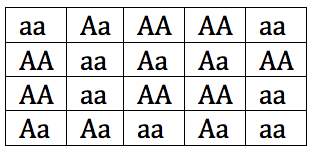
You can see that in this gene pool, the two alleles are evenly distributed. Both “A” and “a” have a frequency of 0.5.
Now imagine that a rock slide kills every mouse except for the two on the bottom right. I’ve put those two in bold and put a line through all of the other mice.
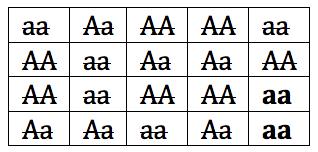
If these two survivors breed, then the new population will have only one allele, “a.” In a few generations, the gene pool will look like this:
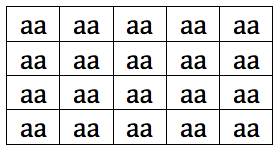
The frequency of “a” is now 1.0, and the frequency of “A” is 0.0. Note that this is NOT about natural selection. There was no survival advantage provided by “a.” The change was completely random. It’s as if we were on a raft that could only hold two individuals. We drifted over to the far corner, and, by chance, picked up two individuals with the genotype “aa.”
Keeping that image in mind, it’s easier to see why genetic drift involves small populations. If our raft were bigger, our random pickup would have resulted in our picking up an “A” allele. The larger the “raft,” the more the sample that we picked up would represent the larger gene pool. Read this slightly edited description of genetic drift from Wikipedia. Click here if you want to read the entire article.
Genetic drift is the change in the frequency of an allele in a population due to random sampling…The law of large numbers predicts little change over time due to genetic drift when the population is large. When the reproductive population is small, however, the effects of sampling error can alter the allele frequencies significantly. Genetic drift is therefore considered to be a consequential mechanism of evolutionary change primarily within small, isolated populations.
5. Genetic drift: Three Case Studies
5a. The Amish: Genetic Drift (and loss of diversity) through the Founder Effect
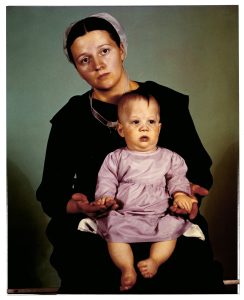
The Amish are a Christian community that lives primarily in rural Pennsylvania. While there is variety among Amish subgroups, “the vast majority of … Amish communities terminate formal education at the eighth grade, meet in homes for religious services, wear distinctive plain clothing, and reject television, online access, and public utility electricity.” source
Ellis-van Creveld is a recessive condition whose symptoms include dwarfism, extra fingers and toes (polydactyly), abnormalities of nails and teeth, and a hole between the upper two chambers of the heart. Among the Amish, the frequency of Ellis-van Creveld syndrome is many times higher than it is in the surrounding non-Amish Pennsylvanian population. Why would this condition be in such high frequency among the Amish?
The Pennsylvania Amish originated from about 200 German immigrants who migrated to Pennsylvania in the mid-1700s. The allele for Ellis-van Creveld syndrome has been traced to one couple from the founding population. Because the Amish tend to marry only within their own culture, this allele has stayed within the Amish gene pool. The higher incidence of children born with this condition relates to the higher likelihood of any two Amish being heterozygous.
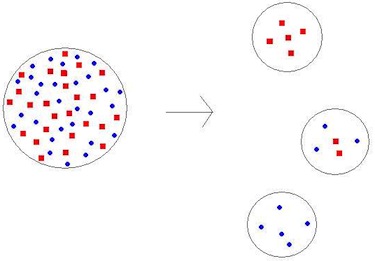
5b. Elephant Seals: Genetic Drift and Loss of Diversity Caused by a Recent Population Bottleneck
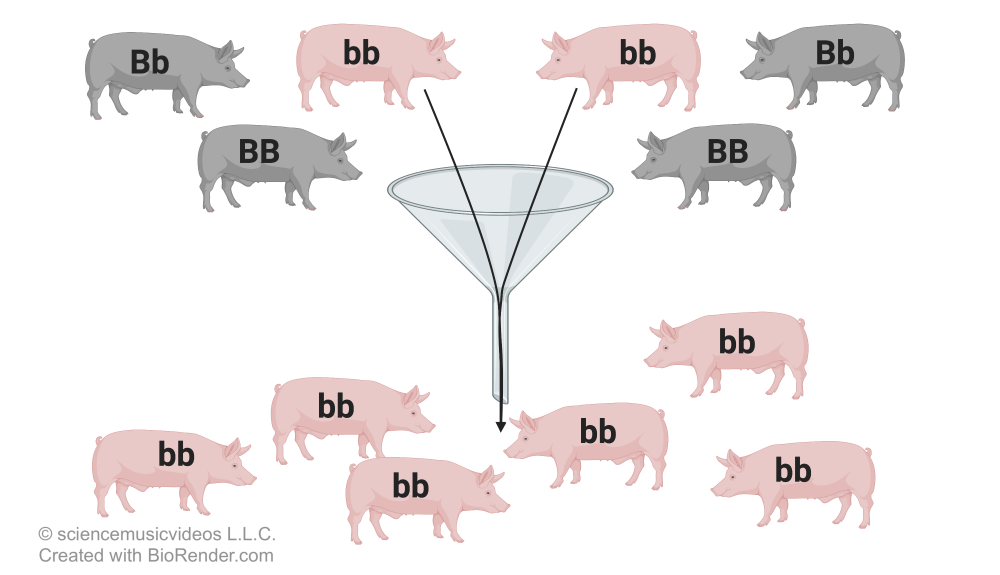
A population bottleneck has the same result as the founder effect (loss of genetic diversity), but the historical cause is different. In a population bottleneck, a large population is severely reduced. Since the survivors represent only a small sample of the previous population, you can predict that as the population recovers, it will have far less genetic diversity than it did before the bottleneck.
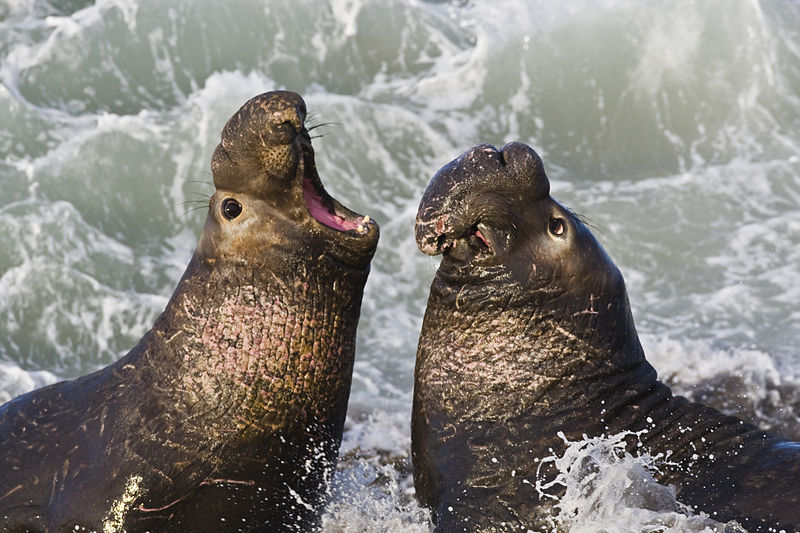
The Northern Elephant Seal, which lives along the West Coast of North America from Alaska down to Baja California, was once hunted to near extinction. By the end of the 1800s, its population may have been as low as 20 individuals. While the population has since rebounded to over 100,000 individuals, genetic studies show that the genetic diversity of the Northern Elephant Seal is much less than that of the closely related Southern Elephant Seal, which lives south of the equator. While Northern Elephant Seals appear to be doing well, biologists fear that their lack of genetic diversity could make them less adaptable to future challenges, including climate change, pollution, and disease.
5c. Cheetahs: Genetic Drift and Loss of Diversity Caused by an Ancient Population Bottleneck

Whereas the population bottleneck that Northern Elephant Seals suffered was observed in recent history, we can infer that cheetahs suffered a similar bottleneck at some time in the past. The evidence is in the cheetah’s gene pool.
A study published in 1987 compared genetic diversity in cheetahs to genetic diversity in other cat species, and in three non-cat species (click here for an article in the NY Times about this study. Click here for a more in-depth article from Scientific American. For the original study (which is, unfortunately, behind a pay wall, click here).
In the bar graph below, Cheetahs are represented by the two sets of bars on the far right. Don’t be intimidated by the terms on the axes. “Frequency of polymorphic loci” means how often a specific gene has more than one allele. In other words, for each gene studied, this quantity measures how often is that gene not fixed, but, rather, accompanied by another allele. “Average heterozygosity” looks at how often, for the alleles being studied, individuals are heterozygous.
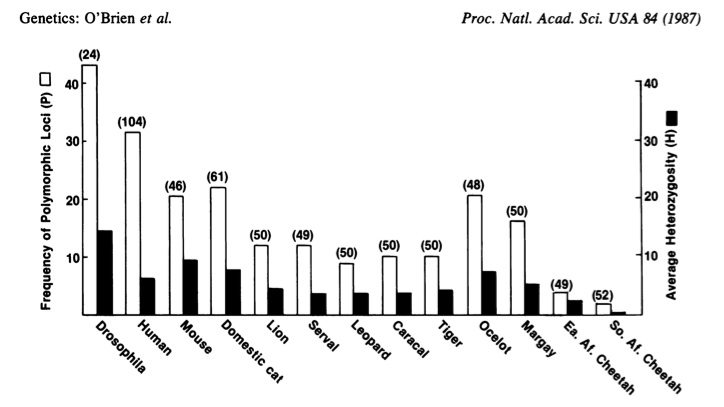
As you can see, the white bars are lower in cheetahs than in any other species. That means that cheetahs have many fewer genes with more than one allele (or, as the graph indicates, many fewer polymorphic loci). Another way of saying that is that many more of the cheetah’s genes are fixed. The black bars are also the lowest, indicating that for any gene studied, cheetahs tend to be much more homozygous, and much less heterozygous.
Simply put, cheetahs have very little genetic diversity. Cheetahs are homozygous for most of their genes. Analysis of 50 blood proteins revealed that the amino acid sequences of those proteins were identical. The genes that code for key tissue protein markers are so similar that cheetahs won’t reject skin grafts from other cheetahs.
Is this a problem? Absolutely. Even with the best of genes, cheetahs would be at risk for extinction from the same loss of habitat that is threatening many African wild species. But if you add to that the cheetah’s low genetic diversity, it puts their population at especially high risk. To begin with, the cheetah’s low variability seems to be causing low fertility. Analysis of cheetah sperm (collected for captive breeding programs) showed that 70% of Cheetah sperm were abnormal. (Original citation from Bioscience, Volume 36, number 6). In captive breeding programs that happen at zoos and wildlife parks, only 10 to 15% of captive cheetahs have been able to successfully breed with one another, and 29.1% of the cubs born die within a year. According to Dr. Stephen O’Brien, head of the research team that produced many of these findings, ”It is not a trivial thing to lose your genetic variation, Genetic variation exists so ecological pressures can be adapted to.”
6. Checking Understanding: Genetic Drift
[qwiz qrecord_id=”sciencemusicvideosMeister1961-Genetic Drift (v2.0)”]
[h]Genetic Drift
[q]Change in allele frequencies caused by random selection and reproduction of alleles is called
[c]IG11dGF0aW9uYWwgdmFyaWF0aW9u[Qq]
[c]IG5hdHVyYWwgc2VsZWN0aW9u[Qq]
[c]IHNleHVhbCBzZWxlY3Rpb24=[Qq]
[c]IGdlbmV0aW MgZHJpZnQ=[Qq]
[f]IE5vLiBXaGF04oCZcyBkZXNjcmliZWQgYWJvdmUgaXMgYSByYW5kb20gcHJvY2Vzcywgd2l0aG91dCBkaXJlY3Rpb24uIFRoaW5rIG9mIHdoYXQgYSByYWZ0IGRvZXMgaW4gYSBzd2ltbWluZyBwb29sLCBhbmQgeW914oCZbGwgaGF2ZSB0aGUgYW5zd2VyLg==[Qq]
[f]IE5vLiBOYXR1cmFsIHNlbGVjdGlvbiBpcyBkaXJlY3Rpb25hbC4gV2hhdOKAmXMgZGVzY3JpYmVkIGFib3ZlIGlzIGEgcmFuZG9tIHByb2Nlc3MsIHdpdGhvdXQgZGlyZWN0aW9uLiBUaGluayBvZiB3aGF0IGEgcmFmdCBkb2VzIGluIGEgc3dpbW1pbmcgcG9vbCwgYW5kIHlvdeKAmWxsIGhhdmUgdGhlIGFuc3dlci4=[Qq]
[f]IE5vLiBTZXh1YWwgc2VsZWN0aW9uIGlzIGRpcmVjdGlvbmFsLiBXaGF04oCZcyBkZXNjcmliZWQgYWJvdmUgaXMgYSByYW5kb20gcHJvY2Vzcywgd2l0aG91dCBkaXJlY3Rpb24uIFRoaW5rIG9mIHdoYXQgYSByYWZ0IGRvZXMgaW4gYSBzd2ltbWluZyBwb29sLCBhbmQgeW914oCZbGwgaGF2ZSB0aGUgYW5zd2VyLg==[Qq]
[f]IFllcy4g4oCYR2VuZXRpYyBkcmlmdOKAmSBpcyBhIGNoYW5nZSBpbiBhbGxlbGUgZnJlcXVlbmNpZXMgY2F1c2VkIGJ5IHJhbmRvbSBzZWxlY3Rpb24gYW5kIHJlcHJvZHVjdGlvbiBvZiBhbGxlbGVzLg==
Cg==[Qq]
[q]Genetic drift is
[c]IGludGVudGlvbmFsLg==[Qq]
[c]IHJhbm RvbS4=[Qq]
[c]IGRpcmVjdGlvbmFsIChsaWtlIG5hdHVyYWwgc2VsZWN0aW9uKS4=[Qq]
[f]IE5vLiBGaXJzdGx5LCB0aGUgd29yZCDigJhpbnRlbnRpb25hbOKAmSBkb2VzbuKAmXQgcmVhbGx5IGFwcGx5IHRvIGFueSB0eXBlIG9mIGV2b2x1dGlvbmFyeSBjaGFuZ2UuIEluIHRoZSBjYXNlIG9mIGdlbmV0aWMgZHJpZnQsIGp1c3QgdGhpbmsgb2YgdGhlIHdvcmQg4oCYZHJpZnQs4oCZIGFuZCBob3cgZHJpZnRpbmcgbW92ZXMgeW91IGFyb3VuZC4=[Qq]
[f]IFllcyBBIGtleSBmZWF0dXJlIG9mIGdlbmV0aWMgZHJpZnQgaXMgaXRzIHJhbmRvbW5lc3MuIEluIGdlbmV0aWMgZHJpZnQsIGNoYW5nZSBpbiBhbGxlbGUgZnJlcXVlbmNpZXMgaXMgY2F1c2VkIGJ5IHJhbmRvbSBzZWxlY3Rpb24gYW5kIHJlcHJvZHVjdGlvbiBvZiBhbGxlbGVz[Qq]
[f]IE5vLiBBIGtleSBmZWF0dXJlIG9mIGdlbmV0aWMgZHJpZnQgaXMgdGhhdCBpdOKAmXMgTk9UIGRpcmVjdGlvbmFsLiBKdXN0IHRoaW5rIG9mIHRoZSB3b3JkIOKAmGRyaWZ0LOKAmSBhbmQgaG93IGRyaWZ0aW5nIG1vdmVzIHlvdSBhcm91bmQsIGFuZCB5b3XigJlsbCBoYXZlIHRoZSBhbnN3ZXIu
Cg==[Qq]
[q]Genetic drift most easily happens in [hangman] populations.
[c]IHNtYWxs[Qq]
[q]Populations that have experienced genetic drift will most likely have _________ variation than populations that haven’t experienced genetic drift.
[c]IHRoZSBzYW1lIGFtb3VudCBvZg==[Qq]
[c]IG1vcmU=[Qq]
[c]IGxl c3M=[Qq]
[f]IE5vLiBHZW5ldGljIGRyaWZ0LCB3aXRoIGl0cyByYW5kb20gc2VsZWN0aW9uIG9mIGFsbGVsZXMsIG1vc3QgbGlrZWx5IHJlc3VsdHMgaW4gcG9wdWxhdGlvbnMgd2l0aCBMRVNTIHZhcmlhdGlvbiB0aGFuIHBvcHVsYXRpb25zIHRoYXQgaGF2ZW7igJl0IGV4cGVyaWVuY2VkIGdlbmV0aWMgZHJpZnQu[Qq]
[f]IE5vLiBHZW5ldGljIGRyaWZ0LCB3aXRoIGl0cyByYW5kb20gc2VsZWN0aW9uIG9mIGFsbGVsZXMsIG1vc3QgbGlrZWx5IHJlc3VsdHMgaW4gcG9wdWxhdGlvbnMgd2l0aCBMRVNTIHZhcmlhdGlvbiB0aGFuIHBvcHVsYXRpb25zIHRoYXQgaGF2ZW7igJl0IGV4cGVyaWVuY2VkIGdlbmV0aWMgZHJpZnQu[Qq]
[f]IFllcy4gR2VuZXRpYyBkcmlmdCwgd2l0aCBpdHMgcmFuZG9tIHNlbGVjdGlvbiBvZiBhbGxlbGVzLCBtb3N0IGxpa2VseSByZXN1bHRzIGluIHBvcHVsYXRpb25zIHdpdGggTEVTUyB2YXJpYXRpb24gdGhhbiBwb3B1bGF0aW9ucyB0aGF0IGhhdmVu4oCZdCBleHBlcmllbmNlZCBnZW5ldGljIGRyaWZ0Lg==
Cg==[Qq]
[q]Populations that have experienced genetic drift will most likely have _________ fixed alleles in their gene pools than populations that haven’t experienced genetic drift.
[c]IHRoZSBzYW1lIGFtb3VudCBvZg==[Qq]
[c]IG1v cmU=[Qq]
[c]IGxlc3M=[Qq]
[f]IE5vLiBHZW5ldGljIGRyaWZ0LCB3aXRoIGl0cyByYW5kb20gc2VsZWN0aW9uIG9mIGFsbGVsZXMsIG1vc3QgbGlrZWx5IHJlc3VsdHMgaW4gcG9wdWxhdGlvbnMgd2l0aCBMRVNTIHZhcmlhdGlvbiB0aGFuIHBvcHVsYXRpb25zIHRoYXQgaGF2ZW7igJl0IGV4cGVyaWVuY2VkIGdlbmV0aWMgZHJpZnQuIExlc3MgdmFyaWF0aW9uIG1lYW5zIE1PUkUgZml4ZWQgYWxsZWxlcy4=[Qq]
[f]IFllcy4gR2VuZXRpYyBkcmlmdCwgd2l0aCBpdHMgcmFuZG9tIHNlbGVjdGlvbiBvZiBhbGxlbGVzLCBtb3N0IGxpa2VseSByZXN1bHRzIGluIHBvcHVsYXRpb25zIHdpdGggTEVTUyB2YXJpYXRpb24gdGhhbiBwb3B1bGF0aW9ucyB0aGF0IGhhdmVu4oCZdCBleHBlcmllbmNlZCBnZW5ldGljIGRyaWZ0LiBMZXNzIHZhcmlhdGlvbiBtZWFucyBNT1JFIGZpeGVkIGFsbGVsZXMu[Qq]
[f]IE5vLiBHZW5ldGljIGRyaWZ0LCB3aXRoIGl0cyByYW5kb20gc2VsZWN0aW9uIG9mIGFsbGVsZXMsIG1vc3QgbGlrZWx5IHJlc3VsdHMgaW4gcG9wdWxhdGlvbnMgd2l0aCBMRVNTIHZhcmlhdGlvbiB0aGFuIHBvcHVsYXRpb25zIHRoYXQgaGF2ZW7igJl0IGV4cGVyaWVuY2VkIGdlbmV0aWMgZHJpZnQuIExlc3MgdmFyaWF0aW9uIG1lYW5zIE1PUkUgZml4ZWQgYWxsZWxlcy4=
Cg==[Qq]
[q]Ellis-van Creveld syndrome is a genetic disease whose symptoms include extra fingers and toes, dwarfism, and heart defects. This disease is in very high frequency among the Amish people who live in Eastern Pennsylvania. The most likely explanation for this is
[c]IG5hdHVyYWwgc2VsZWN0aW9uLg==[Qq]
[c]IHJhbmRvbSBtdXRhdGlvbi4=[Qq]
[c]IGEgcG9wdWxhdGlvbiBib3R0bGVuZWNrLg==[Qq]
[c]IHRoZSBmb3VuZG VyIGVmZmVjdC4=[Qq]
[f]IE5vLiBOYXR1cmFsIHNlbGVjdGlvbiBpbnZvbHZlcyB0aGUgZW52aXJvbm1lbnQgc2VsZWN0aW5nIHBoZW5vdHlwZXMgdGhhdCBhcmUgYmVuZWZpY2lhbCwgYW5kIGFsbGVsZSBmcmVxdWVuY2llcyBzaGlmdGluZyBpbiByZXNwb25zZS4gRWxsaXMtdmFuIENyZXZlbGQgc3luZHJvbWUgaXMgZmFyIGZyb20gYmVuZWZpY2lhbC4=[Qq]
[f]IE5vLiBXaGlsZSBzb21lIGRpc2Vhc2VzIGxpa2UgYWNob25kcm9wbGFzaWEgKGFub3RoZXIgZm9ybSBvZiBkd2FyZmlzbSkgYXJlIG1haW50YWluZWQgYnkgbXV0YXRpb24sIHRoaXMgaXMgbm90IGEgY2F1c2Ugb2YgdGhlIGhpZ2ggaW5jaWRlbmNlIG9mIEVsbGlzLXZhbiBDcmV2ZWxkIHN5bmRyb21lIGFtb25nIHRoZSBBbWlzaC4=[Qq]
[f]IE5vLiBXaGlsZSBFbGxpcy12YW4gQ3JldmVsZCBzeW5kcm9tZSBpcyBhbiBleGFtcGxlIG9mIGdlbmV0aWMgZHJpZnQsIHRoZSBoaXN0b3J5IG9mIHRoZSBBbWlzaCBzaG93cyBubyBwb3B1bGF0aW9uIGJvdHRsZW5lY2su[Qq]
[f]IEV4YWN0bHkuIFRoZSBpbmNpZGVuY2Ugb2YgRWxsaXMtdmFuIENyZXZlbGQgc3luZHJvbWUgaXMgYmVzdCBleHBsYWluZWQgYnkgdGhlIOKAmGZvdW5kZXIgZWZmZWN0LuKAmSBBIHNtYWxsIG51bWJlciBvZiBmb3VuZGVycyBicm91Z2h0IHdpdGggdGhlbSB0aGUgYWxsZWxlIGZvciB0aGlzIHN5bmRyb21lLCBhbmQgdGhpcyBhbGxlbGUgaXMgbm93IGluIGhpZ2ggZnJlcXVlbmN5IGluIHRoZSBBbWlzaCBwb3B1bGF0aW9uLg==
Cg==[Qq]
[q]In the diagram below, the different colored shapes represent different alleles in populations, which are represented by circles. What process is shown in the diagram?
[c]IG5hdHVyYWwgc2VsZWN0aW9u[Qq]
[c]IHJhbmRvbSBtdXRhdGlvbg==[Qq]
[c]IGEgcG9wdWxhdGlvbiBib3R0bGVuZWNr[Qq]
[c]IHRoZSBmb3VuZG VyIGVmZmVjdA==[Qq]
[f]IE5vLiBOYXR1cmFsIHNlbGVjdGlvbiBpbnZvbHZlcyB0aGUgZW52aXJvbm1lbnQgc2VsZWN0aW5nIHBoZW5vdHlwZXMgdGhhdCBhcmUgYmVuZWZpY2lhbCwgYW5kIGFsbGVsZSBmcmVxdWVuY2llcyBzaGlmdGluZyBpbiByZXNwb25zZS4gSGVyZSB5b3Ugc2VlIGEgbGFyZ2UgcGFyZW50IHBvcHVsYXRpb24sIGFuZCBzZXZlcmFsIG5ldyBwb3B1bGF0aW9ucyBiZWluZyBmb3VuZGVkLiBUd28gb2YgdGhlIG5ldyBwb3B1bGF0aW9ucyBoYXZlIGxlc3MgZGl2ZXJzaXR5IG9mIGFsbGVsZXMgdGhhbiB0aGUgcGFyZW50IHBvcHVsYXRpb24u[Qq]
[f]IE5vLiBJZiB0aGlzIHdlcmUgYSByYW5kb20gbXV0YXRpb24sIHlvdeKAmWQgc2VlIG5ldyBhbGxlbGVzIGFwcGVhcmluZy4gSGVyZSB5b3Ugc2VlIGEgbGFyZ2UgcGFyZW50IHBvcHVsYXRpb24sIGFuZCBzZXZlcmFsIG5ldyBwb3B1bGF0aW9ucyBiZWluZyBmb3VuZGVkLiBUd28gb2YgdGhlIG5ldyBwb3B1bGF0aW9ucyBoYXZlIGxlc3MgZGl2ZXJzaXR5IG9mIGFsbGVsZXMgdGhhbiB0aGUgcGFyZW50IHBvcHVsYXRpb24u[Qq]
[f]IE5vLiBBIHBvcHVsYXRpb24gYm90dGxlbmVjayB3b3VsZCBiZXN0IGJlIGRlcGljdGVkIGJ5IG1hbnkgbWVtYmVycyBvZiB0aGUgcGFyZW50IHBvcHVsYXRpb24gYmVpbmcgd2lwZWQgb3V0LCB3aXRoIG9ubHkgYSBmZXcgc3Vydml2b3JzIGxlZnQuIEhlcmUgeW91IHNlZSBhIGxhcmdlIHBhcmVudCBwb3B1bGF0aW9uLCBhbmQgc2V2ZXJhbCBuZXcgcG9wdWxhdGlvbnMgYmVpbmcgZm91bmRlZC4gVHdvIG9mIHRoZSBuZXcgcG9wdWxhdGlvbnMgaGF2ZSBsZXNzIGRpdmVyc2l0eSBvZiBhbGxlbGVzIHRoYW4gdGhlIHBhcmVudCBwb3B1bGF0aW9uLg==[Qq]
[f]IEV4YWN0bHkuIFdoYXTigJlzIHNob3duIGluIHRoaXMgZGlhZ3JhbSBpcyB0aGUgZm91bmRlciBlZmZlY3QuIFlvdSBzZWUgYSBsYXJnZSBwYXJlbnQgcG9wdWxhdGlvbiwgYW5kIHNldmVyYWwgbmV3IHBvcHVsYXRpb25zIGJlaW5nIGZvdW5kZWQuIFR3byBvZiB0aGUgbmV3IHBvcHVsYXRpb25zIGhhdmUgbGVzcyBkaXZlcnNpdHkgb2YgYWxsZWxlcyB0aGFuIHRoZSBwYXJlbnQgcG9wdWxhdGlvbi4=
Cg==[Qq]
[q]What process is shown in the diagram?
[c]IG5hdHVyYWwgc2VsZWN0aW9u[Qq]
[c]IHJhbmRvbSBtdXRhdGlvbg==[Qq]
[c]IGEgcG9wdWxhdGlv biBib3R0bGVuZWNr[Qq]
[c]IHRoZSBmb3VuZGVyIGVmZmVjdA==[Qq]
[f]IE5vLiBOYXR1cmFsIHNlbGVjdGlvbiBpbnZvbHZlcyB0aGUgZW52aXJvbm1lbnQgc2VsZWN0aW5nIHBoZW5vdHlwZXMgdGhhdCBhcmUgYmVuZWZpY2lhbCwgYW5kIGFsbGVsZSBmcmVxdWVuY2llcyBzaGlmdGluZyBpbiByZXNwb25zZS4gSGVyZSB5b3Ugc2VlIGEgbGFyZ2UgcG9wdWxhdGlvbiB0aGF0IGdldHMgcmVkdWNlZCBhbmQgdGhlbiByZWNvdmVycy4gV2hhdCBldmVudCBpbiBwb3B1bGF0aW9uIGdlbmV0aWNzIGhhcyB0aGlzIHBhdHRlcm4/[Qq]
[f]IE5vLiBSYW5kb20gbXV0YXRpb24gYnJpbmdzIGFib3V0IG5ldyBhbGxlbGVzIGluIGEgcG9wdWxhdGlvbi4gVGhlcmXigJlzIG5vIGV2aWRlbmNlIG9mIHRoYXQgaW4gdGhpcyBkaWFncmFtLiBIZXJlIHlvdSBzZWUgYSBsYXJnZSBwb3B1bGF0aW9uIHRoYXQgZ2V0cyByZWR1Y2VkIGFuZCB0aGVuIHJlY292ZXJzLiBXaGF0IGV2ZW50IGluIHBvcHVsYXRpb24gZ2VuZXRpY3MgaGFzIHRoaXMgcGF0dGVybj8=[Qq]
[f]IFllcy4gQSBwb3B1bGF0aW9uIGJvdHRsZW5lY2sgd291bGTCoGJlIGRlcGljdGVkIGJ5IG1hbnkgbWVtYmVycyBvZiB0aGUgcGFyZW50IHBvcHVsYXRpb24gYmVpbmcgd2lwZWQgb3V0LCB3aXRoIG9ubHkgYSBmZXcgc3Vydml2b3JzIGxlZnQuIFRoZSBzdXJ2aXZvcnMgdGhlbiByZWJ1aWxkIHRoZSBwb3B1bGF0aW9uLiBUaGF04oCZcyBleGFjdGx5IHdoYXQgeW91IHNlZSBpbiB0aGlzIGRpYWdyYW0u[Qq]
[f]IE5vLiBUaGUgZm91bmRlciBlZmZlY3Qgd291bGQgYmUgc2hvd24gYnkgYSBmZXcgaW5kaXZpZHVhbHMgYnJhbmNoaW5nIG9mZiBmcm9tIGEgcGFyZW50IHBvcHVsYXRpb24gdG8gZm9ybSBhIG5ldyBwb3B1bGF0aW9uLiBIZXJlIHlvdSBzZWUgYSBsYXJnZSBwb3B1bGF0aW9uIHRoYXQgZ2V0cyByZWR1Y2VkIGFuZCB0aGVuIHJlY292ZXJzLiBXaGF0IGV2ZW50IGluIHBvcHVsYXRpb24gZ2VuZXRpY3MgaGFzIHRoaXMgcGF0dGVybj8=
Cg==[Qq]
[q]Genetically, the cheetah is an example of a species that experienced
[c]IHRoZSBmb3VuZGVyIGVmZmVjdC4=[Qq]
[c]IGEgcG9wdWxhdGlvbi Bib3R0bGVuZWNrLg==[Qq]
[f]IE5vLiBXaGlsZSB0aGUgY2hlZXRhaCBnZW5lIHBvb2wgaXMgYW4gZXhhbXBsZSBvZiBnZW5ldGljIGRyaWZ0LCB0aGUgc3BlY2lmaWMgbWVjaGFuaXNtIGRvZXMgbm90IGxvb2sgbGlrZSB0aGUgZm91bmRlciBlZmZlY3Qu[Qq]
[f]IFllcy4gVGhlIGNoZWV0YWjigJlzIGV4dHJlbWUgbGFjayBvZiBnZW5ldGljIGRpdmVyc2l0eSBpbmRpY2F0ZXMgdGhhdCB0aGUgY2hlZXRhaCBleHBlcmllbmNlZCBhIHBvcHVsYXRpb24gYm90dGxlbmVjayBpbiB0aGUgcGFzdCwgd2lwaW5nIG91dCBtb3N0IG9mIHRoZSBnZW5ldGljIHZhcmlhdGlvbiBpbiB0aGUgY2hlZXRhaCBnZW5lIHBvb2wu
Cg==[Qq]
[q]One consequence of the population bottleneck experienced by the Northern elephant seal is
[c]IGxvdyBnZW5ldGlj IHZhcmlhYmlsaXR5[Qq]
[c]IGhpZ2ggcmF0ZXMgb2YgbXV0YXRpb24=[Qq]
[c]IGhpZ2ggZ2VuZXRpYyB2YXJpYWJpbGl0eQ==[Qq]
[f]IFllcy4gVGhlIE5vcnRoZXJuIGVsZXBoYW50IHNlYWwsIHRob3VnaCBpdCBoYXMgYmVlbiBzdWNjZXNzZnVsIGluIHJlYnVpbGRpbmcgaXRzIHBvcHVsYXRpb24sIGhhcyBsb3cgZ2VuZXRpYyB2YXJpYWJpbGl0eS4=[Qq]
[f]IE5vLiBUaGVyZeKAmXMgbm8gZXZpZGVuY2UgdGhhdCBtdXRhdGlvbiByYXRlcyBhcmUgYW55IGhpZ2hlciBpbiBOb3J0aGVybiBlbGVwaGFudCBzZWFscyB0aGFuIHRoZXkgYXJlIGluIGFueSBvdGhlciBwb3B1bGF0aW9uLg==[Qq]
[f]IE5vLiBQb3B1bGF0aW9uIGJvdHRsZW5lY2tzLCBzdWNoIGFzIHRoYXQgZXhwZXJpZW5jZWQgYnkgdGhlIE5vcnRoZXJuIEVsZXBoYW50IFNlYWwsIGRvIG5vdCBpbmNyZWFzZSBnZW5ldGljIHZhcmlhYmlsaXR5Lg==[Qq]
[x]
[restart]
[/qwiz]
8. What’s next?
This is the last tutorial in AP Bio Topic 7.4 – 7.5, Population Genetics. To consolidate your mastery of this topic, proceed to the Population Genetics Cumulative Flashcards and Quiz.
